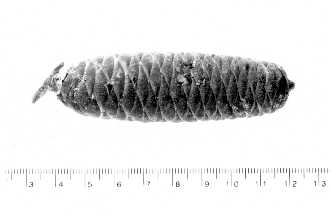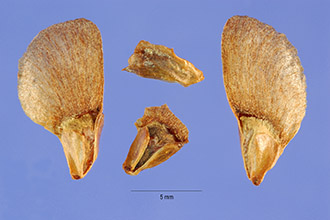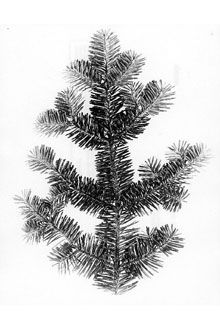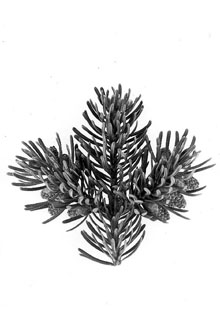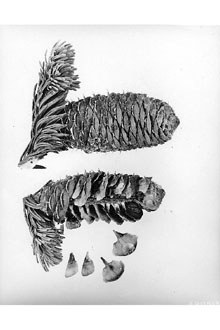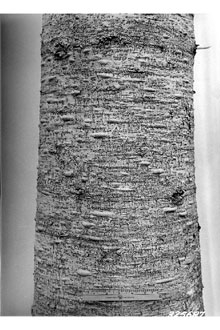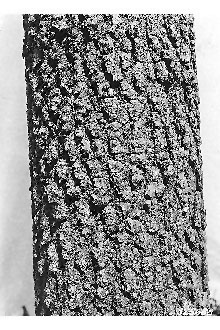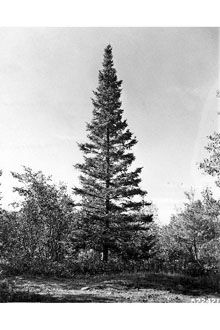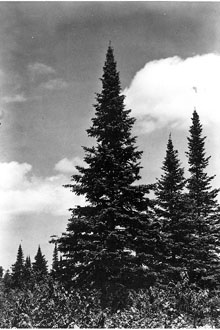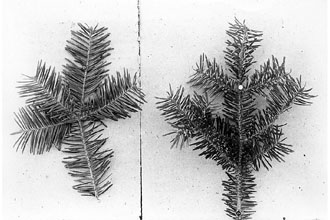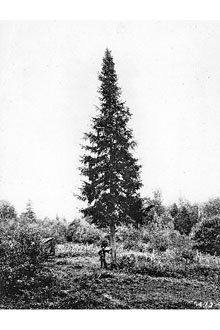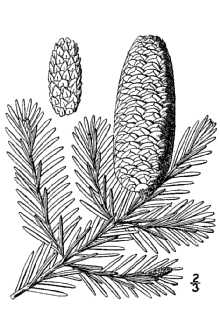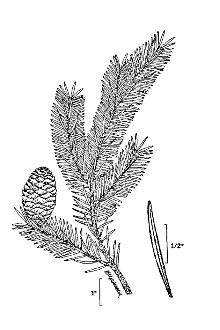Balsam Fir
Scientific Name: Abies balsamea (L.) Mill.
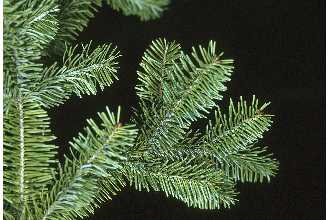
| General Information | |
|---|---|
| Usda Symbol | ABBA |
| Group | Gymnosperm |
| Life Cycle | Perennial |
| Growth Habits | Tree |
| Native Locations | ABBA |
Plant Guide
Use a soil moisture meter to monitor the soil moisture where Balsam Fir is planted.
Fact Sheet
Alternate Names
Pinus balsamea L.
Uses
Balsam fir is used primarily for Christmas trees and pulpwood, although some lumber is produced from it in New England and the Lake States. The wood is light in weight, low in bending and compressive strength, moderately limber, soft, and low in resistance to shock.
Status
Please consult the PLANTS Web site and your State Department of Natural Resources for this plant’s current status (e.g. threatened or endangered species, state noxious status, and wetland indicator values).
Description
Balsam fir is a small to medium sized coniferous tree. Growth occurs in whorls of branches surrounding an upright leader or terminal, making a symmetrical tree with a broad base and narrow top. It is relatively short-lived and is considered a sub-climax type species in the New England states, but may be a climax type in the zone below timberline. Needles are 3/4 to 1 inch long, flat, and often strongly curved. Twigs with needles have a generally flattened appearance. Both male and female flowers are found on the same branch. Cones are 2 to 4 inches long, purplish in color, and stand erect on branches (as do those of all true firs). There are about 60,000 seeds in a pound. The bark is smooth, thin, and grayish, distinguished by soft blisters containing a clear, odiferous resin known as Canadian balsam. Robert H. Mohlenbrock USDA NRCS 1995 Northeast Wetland Flora @ USDA NRCS PLANTS
Adaptation and Distribution
Distribution
Distribution
The soils on which balsam fir grows range from silt loams developed from lake deposits to stony loams derived from glacial till, Use soil moisture sensors to measure the soil moisture of Balsam Fir., Fir will grow, but comparatively slowly, on gravelly sands and in peat bogs, It grows on soils of pH ranging from 4,0 to 6,0, It is generally found in areas with a cold moist climate and with 30 inches or more of annual precipitation, Fir is subject to windthrow, especially on shallow wet soils, Because of its thin bark, shallow root system, and flammable needles, balsam fir is easily killed by fire, Balsam fir is distributed throughout the Northeast and upper Midwest, For a current distribution map, please consult the Plant Profile page for this species on the PLANTS Website,
Establishment
The use of natural regeneration methods for balsam fir is very effective on open and disturbed sites (heavily cut areas), but an adequate seed source must exist. This species can also be readily grown in nurseries, for transplanting to abandoned fields, Christmas tree plantations, and open areas. Use conventional tree planting techniques and equipment. Three or four year old seedling stock should be utilized.
Plant Traits
Growth Requirements
| Temperature, Minimum (°F) | -43 |
|---|---|
| Adapted to Coarse Textured Soils | Yes |
| Adapted to Fine Textured Soils | Yes |
| Adapted to Medium Textured Soils | Yes |
| Anaerobic Tolerance | None |
| CaCO3 Tolerance | Low |
| Cold Stratification Required | Yes |
| Drought Tolerance | Low |
| Fertility Requirement | Medium |
| Fire Tolerance | Low |
| Frost Free Days, Minimum | 80 |
| Hedge Tolerance | Low |
| Moisture Use | Medium |
| pH, Maximum | 6.0 |
| pH, Minimum | 4.0 |
| Planting Density per Acre, Maxim | 1200 |
| Planting Density per Acre, Minim | 300 |
| Precipitation, Maximum | 60 |
| Precipitation, Minimum | 13 |
| Root Depth, Minimum (inches) | 20 |
| Salinity Tolerance | None |
| Shade Tolerance | Tolerant |
Morphology/Physiology
| Bloat | None |
|---|---|
| Toxicity | None |
| Resprout Ability | No |
| Shape and Orientation | Conical |
| Active Growth Period | Spring and Summer |
| C:N Ratio | High |
| Coppice Potential | No |
| Fall Conspicuous | No |
| Fire Resistant | No |
| Flower Color | Yellow |
| Flower Conspicuous | No |
| Foliage Color | Green |
| Foliage Porosity Summer | Dense |
| Foliage Porosity Winter | Dense |
| Foliage Texture | Medium |
| Fruit/Seed Conspicuous | No |
| Nitrogen Fixation | None |
| Low Growing Grass | No |
| Lifespan | Short |
| Leaf Retention | Yes |
| Known Allelopath | No |
| Height, Mature (feet) | 60.0 |
| Height at 20 Years, Maximum (fee | 18 |
| Growth Rate | Slow |
| Growth Form | Single Stem |
| Fruit/Seed Color | Brown |
Reproduction
| Vegetative Spread Rate | None |
|---|---|
| Small Grain | No |
| Seedling Vigor | Low |
| Seed Spread Rate | Slow |
| Fruit/Seed Period End | Fall |
| Seed per Pound | 59840 |
| Propagated by Tubers | No |
| Propagated by Sprigs | No |
| Propagated by Sod | No |
| Propagated by Seed | Yes |
| Propagated by Corm | No |
| Propagated by Container | Yes |
| Propagated by Bulb | No |
| Propagated by Bare Root | Yes |
| Fruit/Seed Persistence | No |
| Fruit/Seed Period Begin | Fall |
| Fruit/Seed Abundance | Medium |
| Commercial Availability | Routinely Available |
| Bloom Period | Mid Summer |
| Propagated by Cuttings | No |
Suitability/Use
| Veneer Product | Yes |
|---|---|
| Pulpwood Product | Yes |
| Protein Potential | Low |
| Post Product | No |
| Palatable Human | No |
| Palatable Browse Animal | Medium |
| Nursery Stock Product | Yes |
| Naval Store Product | Yes |
| Lumber Product | Yes |
| Fuelwood Product | Low |
| Fodder Product | No |
| Christmas Tree Product | Yes |
| Berry/Nut/Seed Product | No |

